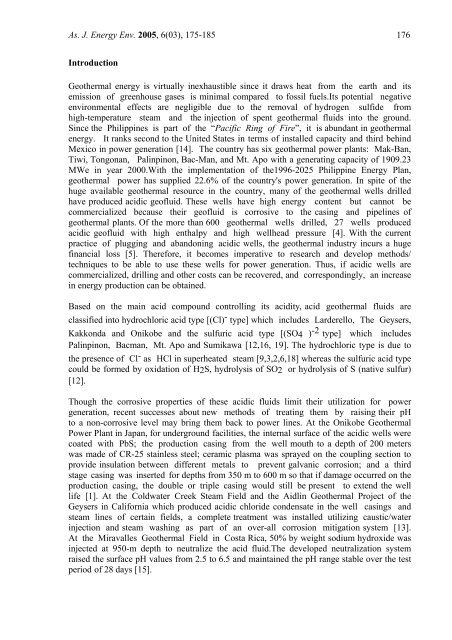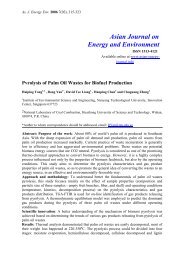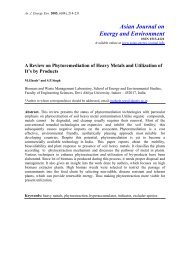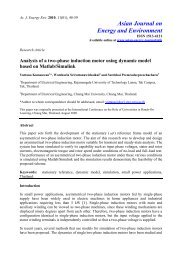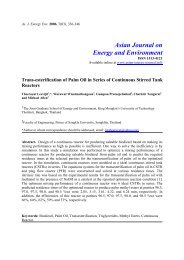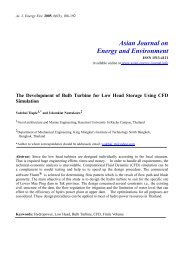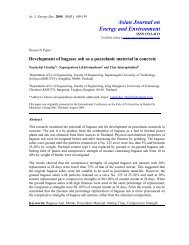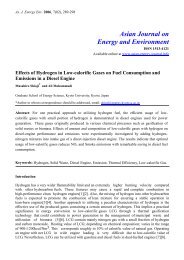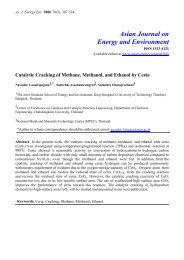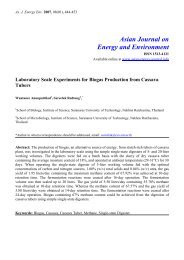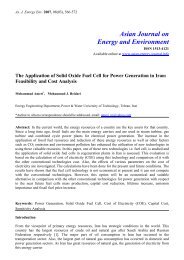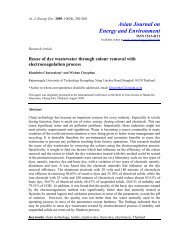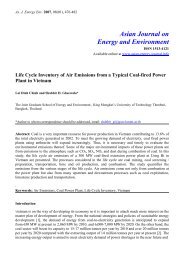Commercialisation of acidic geothermal wells by ph buffering
Commercialisation of acidic geothermal wells by ph buffering
Commercialisation of acidic geothermal wells by ph buffering
You also want an ePaper? Increase the reach of your titles
YUMPU automatically turns print PDFs into web optimized ePapers that Google loves.
As. J. Energy Env. 2005, 6(03), 175-185 176IntroductionGeothermal energy is virtually inexhaustible since it draws heat from the earth and itsemission <strong>of</strong> greenhouse gases is minimal compared to fossil fuels.Its potential negativeenvironmental effects are negligible due to the removal <strong>of</strong> hydrogen sulfide fromhigh-temperature steam and the injection <strong>of</strong> spent <strong>geothermal</strong> fluids into the ground.Since the Philippines is part <strong>of</strong> the “Pacific Ring <strong>of</strong> Fire”, it is abundant in <strong>geothermal</strong>energy. It ranks second to the United States in terms <strong>of</strong> installed capacity and third behindMexico in power generation [14]. The country has six <strong>geothermal</strong> power plants: Mak-Ban,Tiwi, Tongonan, Palinpinon, Bac-Man, and Mt. Apo with a generating capacity <strong>of</strong> 1909.23MWe in year 2000.With the implementation <strong>of</strong> the1996-2025 Philippine Energy Plan,<strong>geothermal</strong> power has supplied 22.6% <strong>of</strong> the country's power generation. In spite <strong>of</strong> thehuge available <strong>geothermal</strong> resource in the country, many <strong>of</strong> the <strong>geothermal</strong> <strong>wells</strong> drilledhave produced <strong>acidic</strong> ge<strong>of</strong>luid. These <strong>wells</strong> have high energy content but cannot becommercialized because their ge<strong>of</strong>luid is corrosive to the casing and pipelines <strong>of</strong><strong>geothermal</strong> plants. Of the more than 600 <strong>geothermal</strong> <strong>wells</strong> drilled, 27 <strong>wells</strong> produced<strong>acidic</strong> ge<strong>of</strong>luid with high enthalpy and high wellhead pressure [4]. With the currentpractice <strong>of</strong> plugging and abandoning <strong>acidic</strong> <strong>wells</strong>, the <strong>geothermal</strong> industry incurs a hugefinancial loss [5]. Therefore, it becomes imperative to research and develop methods/techniques to be able to use these <strong>wells</strong> for power generation. Thus, if <strong>acidic</strong> <strong>wells</strong> arecommercialized, drilling and other costs can be recovered, and correspondingly, an increasein energy production can be obtained.Based on the main acid compound controlling its acidity, acid <strong>geothermal</strong> fluids areclassified into hydrochloric acid type [(Cl) - type] which includes Larderello, The Geysers,Kakkonda and Onikobe and the sulfuric acid type [(SO4 ) -2 type] which includesPalinpinon, Bacman, Mt. Apo and Sumikawa [12,16, 19]. The hydrochloric type is due tothe presence <strong>of</strong> Cl - as HCl in superheated steam [9,3,2,6,18] whereas the sulfuric acid typecould be formed <strong>by</strong> oxidation <strong>of</strong> H2S, hydrolysis <strong>of</strong> SO2 or hydrolysis <strong>of</strong> S (native sulfur)[12].Though the corrosive properties <strong>of</strong> these <strong>acidic</strong> fluids limit their utilization for powergeneration, recent successes about new methods <strong>of</strong> treating them <strong>by</strong> raising their pHto a non-corrosive level may bring them back to power lines. At the Onikobe GeothermalPower Plant in Japan, for underground facilities, the internal surface <strong>of</strong> the <strong>acidic</strong> <strong>wells</strong> werecoated with PbS; the production casing from the well mouth to a depth <strong>of</strong> 200 meterswas made <strong>of</strong> CR-25 stainless steel; ceramic plasma was sprayed on the coupling section toprovide insulation between different metals to prevent galvanic corrosion; and a thirdstage casing was inserted for depths from 350 m to 600 m so that if damage occurred on theproduction casing, the double or triple casing would still be present to extend the welllife [1]. At the Coldwater Creek Steam Field and the Aidlin Geothermal Project <strong>of</strong> theGeysers in California which produced <strong>acidic</strong> chloride condensate in the well casings andsteam lines <strong>of</strong> certain fields, a complete treatment was installed utilizing caustic/waterinjection and steam washing as part <strong>of</strong> an over-all corrosion mitigation system [13].At the Miravalles Geothermal Field in Costa Rica, 50% <strong>by</strong> weight sodium hydroxide wasinjected at 950-m depth to neutralize the acid fluid.The developed neutralization systemraised the surface pH values from 2.5 to 6.5 and maintained the pH range stable over the testperiod <strong>of</strong> 28 days [15].


